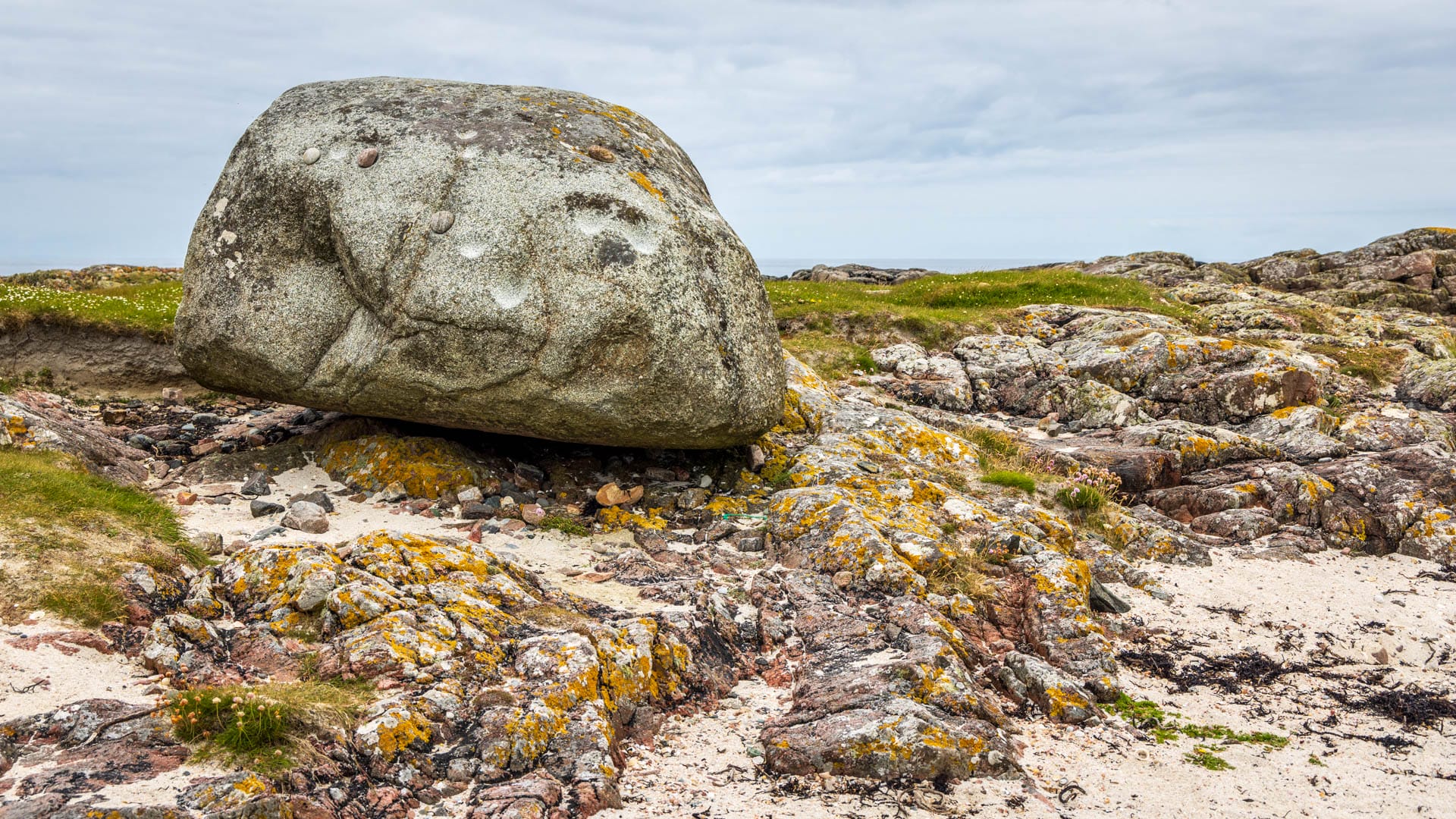A hike on the small island of Tiree takes visitors to the Ringing Stone. Find out why it’s called that and what else there is to see here.

An erratic boulder surrounded by grass and sand. There are circular indentations in its flank. And if you tap a stone against the rock, it produces an almost musical sound.
This Ringing Stone has its home on the Hebridean island of Tiree. It is so important there that it is said that if it were destroyed, the whole island would sink with it. There is no road leading to it, but a short walk along the beautiful coastline.
The rock, which is around one and a half metres high, is not only a mystery because of its musicality, its shape and composition also raise questions. This is because Tiree is dominated by ancient Lewis gneiss, one of the oldest rocks in Britain. The Ringing Stone, on the other hand, is much younger and was probably pushed over from the island of Rùm during the Ice Age. Poetic people, however, prefer to say that a giant threw it over from the Isle of Mull.
On its side, the Ringing Stone has a total of 53 “cup marks”, i.e. indentations that people carved into it in the Stone Age. What they were used for is unknown. Today, however, they are used to store small stones that can be used to “play” with the large stone. And that sounds like this:
Almost on the way to this rock is a broch, a fortress from the Iron Age around 60 BC, as was common on the coasts of Scotland at the time.
The so-called Dùn Mòr of Vaul on its mound is over nine metres in diameter. A gate, a chamber for a guard, a fireplace in the middle, thick, double walls that once towered metres high – this ruin shows what a complex structure such fortresses once were.
Later, the Vikings also used the fortress before it fell into disrepair.
If you want to visit the Ringing Stone and the Dùn, you should be reasonably good on foot. The reward for your efforts, however, is not only the two sights but also a wild coastal landscape.
The hike: Map to the Ringing Stone Tiree
Distance: approx. 7.2 kilometres, walking time: approx. 2:30 hours, terrain: mostly no visible path, meadow, muddy after rain.
The tour leads directly along the western side (“left”) of Vaul Bay beach. Here you can still recognise a path that passes an old stone gate. The coastline here has wonderful blue water, green grass and grey rocks.
The path soon passes a house. Keep to the right here. A hill rises in the distance with a plateau at the top. This is the small fortress – Dùn Beag. However, there are no more remains up there, just a good panoramic view.
Continue along the path, past the small hut and over the steps next to a cattle gate. There is already a sign for the nearby Dùn Mòr near Vaul.
The hill with the Broch, often populated by goats, soon rises up on the right. You have to climb it to explore the fortress.
Then back onto the path, which is barely visible. It passes a small hole on the left. A section of a headland can be cut off roughly parallel to the coast. A fence appears, on which a red builder’s helmet and a waymarker mark the steps over the obstacle.
Roughly speaking, you should always keep to the coast on the right. The Ringing Stone soon comes into view. The way back is via the outward route.
Approach
With navigation device: “PA77 6TP” is the postcode for Vaul. Rest as described below.
Without sat nav: First take the main road B8068, then turn right towards Caolas onto the B8069. Drive along the bay until you see a house on the left and a red letterbox opposite on the right. Turn left here towards Vaul.
Park at the end of the road at Vaul Bay. There is a small exit on the right where you can park your vehicle. However, park in such a way that no traffic is blocked on the farm.